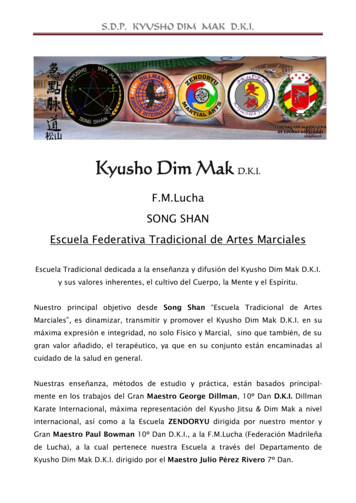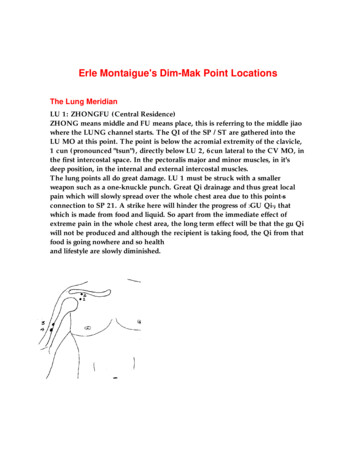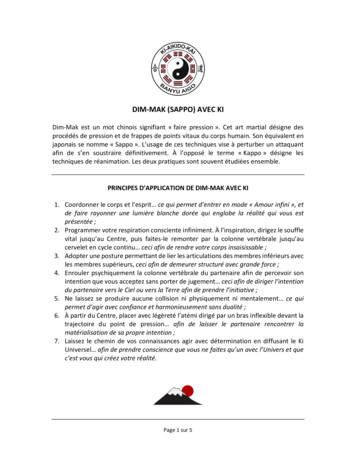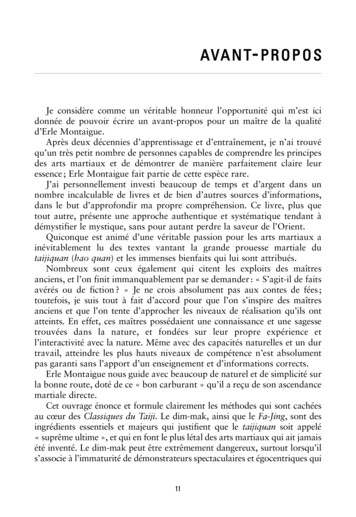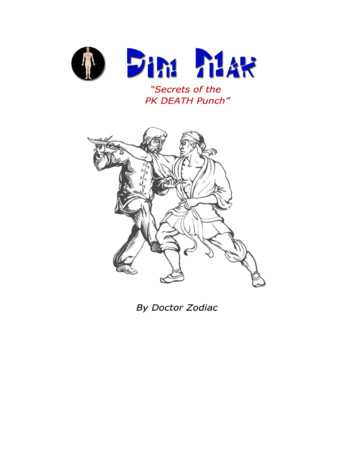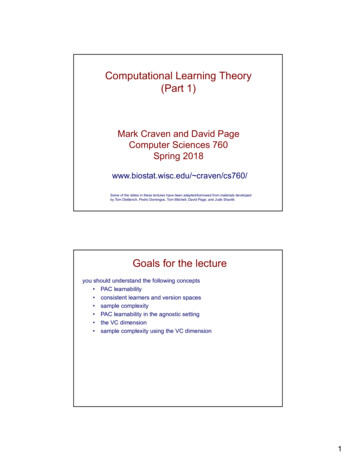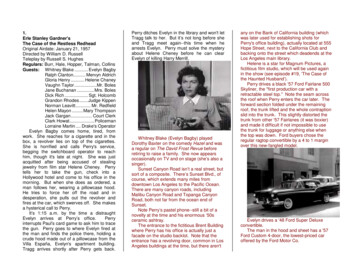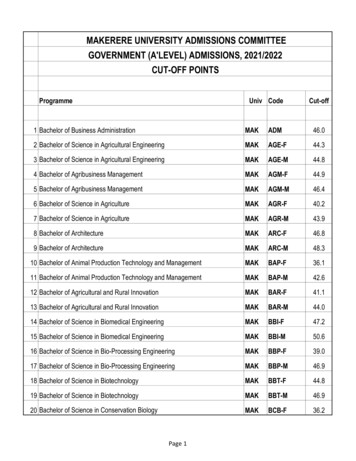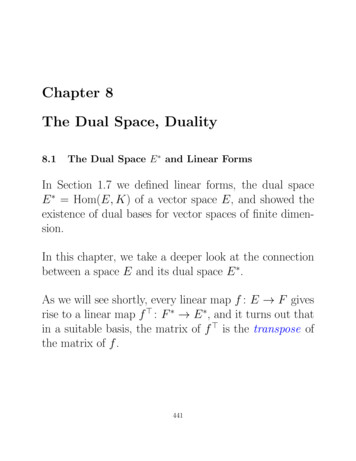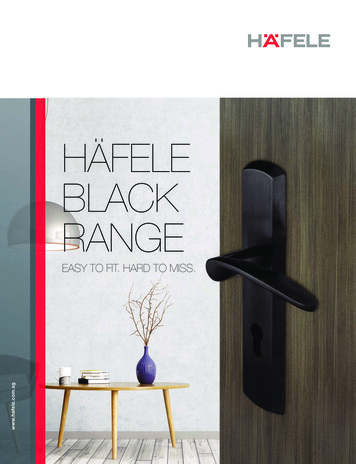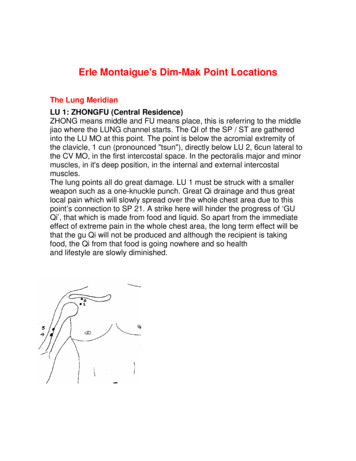
Transcription
Erle Montaigue's Dim-Mak Point LocationsThe Lung MeridianLU 1: ZHONGFU (Central Residence)ZHONG means middle and FU means place, this is referring to the middlejiao where the LUNG channel starts. The QI of the SP / ST are gatheredinto the LU MO at this point. The point is below the acromial extremity ofthe clavicle, 1 cun (pronounced "tsun"), directly below LU 2, 6cun lateral tothe CV MO, in the first intercostal space. In the pectoralis major and minormuscles, in it's deep position, in the internal and external intercostalmuscles.The lung points all do great damage. LU 1 must be struck with a smallerweapon such as a one-knuckle punch. Great Qi drainage and thus greatlocal pain which will slowly spread over the whole chest area due to thispoint’s connection to SP 21. A strike here will hinder the progress of ‘GUQi’, that which is made from food and liquid. So apart from the immediateeffect of extreme pain in the whole chest area, the long term effect will bethat the gu Qi will not be produced and although the recipient is takingfood, the Qi from that food is going nowhere and so healthand lifestyle are slowly diminished.
LU 2: YUNMEN (Cloud's Door)In the depression below the acromial extremity of the clavicle, between thepectoralis major and the deltoid muscles, six cun lateral to the CV channel.When this point is struck upwards into the clavicle it produces adevastating affect upon the Qi system of the whole body. The pain istremendous and Qi drainage also. Great internal damage can be done withlittle external appearance. This will cause a knock out or even deaththrough Qi drainage.When the point is struck from the top above the clavicle, the collarbone willbe broken along with the Qi drainage and even more pain! However,because the collarbone is able to take some of the pressure from thisstrike, even though it breaks, the likelihood of death is lessened. Thedownward strike will stop a confrontation really fast though.LU 3: TIANFU (Heaven's Residence)On the medial aspect of the upper arm, 3 cun below the end of the axillaryfold, on the radial side of the biceps brachii, 6 cun above LU 5.Immediately there is like an electrical shock that goes up and down the armcausing momentary or long lasting paralysis of the arm. Being a ‘window ofthe sky’ point it will also upset totally, the balance between ‘heaven andearth’ or head and body causing great emotional problems that will only getworse if left untreated. Emotionally caused problems such as confusion
and loss of memory will occur at a later stage. This strike will also give anextreme case of instant vertigo!At a healing level, this point is a really good one for nosebleed, using fingerpressure mildly over the point on both arms.LU 4: XIABAI (Gallantry)XIA means to press from both sides, Bai means white, when both arms arehanging freely, this point is precisely on both sides of the LUNGS. On themedial aspect of the upper arm, 1 cun below LU 3, on the radial side of thebiceps brachii.This point immediately does the same as LU 3 only the local pain andelectrical shock is a little worse. This is also a great nerve strike which cancause the brain to shut down the body, not knowing what has happened.Emotional problems will also occur later, but not as severe as for LU 3.LU 5: CHIZE (Cubit Marsh)CHI means ruler or ulna, ZE means marsh, the CHI part of the name refersto the ulna aspect (from the wrist to the elbow). The point is in thedepression of the elbow fossa at the ulna aspect. The QI of the channel isinfused here, like water flowing into a marsh. On the cubital crease, on theradial side of the tendon of the biceps brachii. The point is located with theelbow slightly flexed. Located in the origin of the brachioradialis muscle.This point can cause great damage to the whole system. It can causeknock out when struck with for instance a back-palm and using a ‘deadarm’. This is where the arm is totally loose with no tension at all and isthrown at the target making use of the heaviness of the arm itself. It can beused as I have already mentioned several times, as a set up point, or it canbe used all by itself as a devastating strike. The whole upper body is putout of balance both physically and Qi wise. A strong strike can also causebrain damage. Because this point is a ‘he’ point, when struck rather thanused for healing, it will take Qi away from the lungs. In addition, as thelungs are part of the power system of the body, you will lose powerinstantly.LU 6: KONGZUI (Opening Maximum or Supreme Hole)On the palmar aspect of the forearm, on the line joining LU 9 to LU 5, 7 cunabove LU 9. The point is in the brachioradialis muscle, in the lateral marginat the upper extremity of the pronator teres muscle and the medial marginof the extensor carpi radialis brevis and longus muscles.
Lower arm paralysis is immediate with a hard strike. The recipient will feellike he has been struck in the lungs. This is a xi-cleft point. A strike herecauses the reverse effect of healing using this point. It is an emergencypoint and can release much needed Qi to the lungs in an emergency suchas being struck in the lungs. So this point can be used as an after shot,after striking the attacker in the lung area. The body calls for its reserve ofQi, but it is unavailable because of the second strike to LU 6! The recipientto such a strike could die within minutes.LU 7: LIEQUE (Broken Sequence or Every Deficiency)Superior to the styloid process of the radius, 1.5 cun above the transversecrease of the wrist, in the depression. When the index fingers and thethumbs of both hands are crossed with the index finger of one hand placedon the styloid process of the radius of the other, the point is in thedepression under the tip of the index finger. Between the tendons of thebrachioradialis and the abductor pollicis longus muscles.Although this strike is ‘only on the wrist’, it is quite a nasty one as it createsgreat pain and Qi drainage. Even heavy finger pressure here as is the caseof a lock, will cause great pain. The Qi drainage and pain are so bad thatthe recipient has to sit down. I have had one instance where a knock outoccurred with only a light strike. A strike here will unbalance the balance ofyin and yang between the lung and colon causing artificial grief with muchsobbing. Also, the ability to learn physical things will be impaired and willget worse as time goes by.LU 8: JINGQU (Across the Ditch)One cun above the transverse crease of the wrist, in the depression on theradial side of the radial artery. Innervation: The lateral antebrachialcutaneous nerve and the superficial ramus of the radial nerve.Great Qi drainage, thus setting up other points for attack. HT 5 by itself hasbeen known to cause knock out when needled too much, same for LU 8.LU 8 is a metal and jing point. This is the horary point of the channel andas such when struck will cause the Qi to be disrupted in the channel whenit is supposed to be active during the 24-hour cycle. Thus, the lungs will notbe at their peak throughout the day. This Qi imbalance will get worse aseach day passes until a healing is affected. Sleep will be affected greatlyespecially between the hours of 3 am and 5 am with the need to urinatebecause the bladder meridian is at the opposite side of the horary cycleand as such will have the least amount of Qi available to it at this time.LU 9: TAIYUAN (Great Abyss or Bigger Deep Hole)At the transverse crease of the wrist, in the depression on the radial side ofthe radial artery. At the lateral aspect of the tendon of the flexor carpi
radialis muscle and the medial aspect of the tendon of the abductor pollicislongus muscle.This is again a great Qi drainage point. It is an ‘earth, yuan and shu’ pointand a special meeting point of pulse (arteries and veins). This point mustbe struck right on the point so it is not a point that I would use in a tightsituation, although it works quite well as a set up point causing great localpain and Qi drainage. It will cause respiration to become erratic causing therecipient to think he is going to be suffocated.LU 10: YUJI (Fish Border)On the radial aspect of the midpoint of the first metacarpal bone, at thejunction of the red and white skin (the lighter coloured and darker colouredskin). In the lateral abductor pollicis brevis and opponents pollicis muscles.This is not a point to use in a realistic fighting situation. If struck very hard,it will cause heat to rise in the lungs causing coughing. It is more of ahealing point this one and is used to eliminate heat from the lungs thuseasing sore throats etc. It is a fire and yong point.LU 11: SHAOSHANG (Lessor Merchant)On the radial side of the thumb, about 0.1 cun posterior to the radial cornerof the nail.This is a wood and cheng point and can be used for muscles and tendons,the healing of. If struck with perhaps a hammer, it will drain Qi from theupper body and can cause emotional problems later in life. It is more usedfor throat and tonsils in particular. It is also used to increase the Wei Qi tothe surface of the skin when external pathogenic attack is imminent.END OF LUNG MERIDIANThe Colon Meridian Back to topCO 1: SHANGYANG (Trade (Merchant) Yang)On the radial side of the index finger, about 0.1 cun posterior to the cornerof the nail.This is a metal and cheng point and is only ever used in the healing art. Itclears ‘wind/heat’. It is an emergency point for coma and should be bled forthis purpose; in fact, all ‘cheng’ points are bled. It will also drag Qi to theextremities to strengthen the outer limbs.CO 2: ERJIAN (Between Two)ER means 2 and JIAN means clearance, JIAN here indicates the POINT,this is the second PT on the COLON MO. On the radial side of the index
finger, distal to the metacarpophalangeal joint, at the junction of the redand white skin in the depression.It is a water and yong point and as such can be used as a set up point forCO 5 (fire). An excellent point to relieve constipation. Should you be able toget one finger exactly onto CO 2 and also dig one finger into CO 5, this hasbeen known to cause knock out. However, while you are doing this, he willprobably knock you out!CO 3: SANJIAN (Between Three)SAN means three and jian means clearance, here jian indicates thePOINT, this is the third POINT on the CO MO. When a loose fist is made,the PT is on the radial side of the index finger, in the depression proximalto the head of the second metacarpal bone.Use with CO 2. It is a wood and shu point. A good strike here, if you canget it, can cause temporary blindness, however I must warn that this is verydifficult to achieve.CO 4: HEGU (Adjoining Valleys)Between the first and second metacarpal bones, approximately in themiddle of the second metacarpal bone on the radial side. Roughly between
the second metacarpal bone and the end of the crease created when thethumb is adducted, in the dorsal interroseus muscle, in it's deep position, inthe transverse head of the abductor hallcis muscle.This point does some damage in Qi drainage and local pain. It can be usedas a set up point to a LU 1 shot or to a LIV 14 shot. Struck right on thepoint with a smaller weapon such as a one-knuckle punch, this point willcause confusion in the brain. However, it is not easy to strike as that strikemust be very accurate.CO 5: YANGXI (Adjoining Valley)Yang refers to the Yang mountains created by the tendons in this area, Ximeans brook. The depression of this Point is like a brook in the mountains.On the radial side of the wrist, when the thumb is tilted upwards, the pointis in the depression between the tendons of the extensor pollicis longusand brevis.This is one of the ‘natural’ short out points with SI 2 that will cause greatpain and allow you to put someone down onto their knees easily. Applyingpressure straight across the back of the wrist diagonally will short out CO 5and SI 2 (Fire and water respectively).CO 6: PIANLI (Partial Order)Three cun above CO 5 on the line joining CO 5 and CO 11. On the radialside, the lateral antebrachial cutaneous nerve and the superficial ramus ofthe radial nerve, on the u1nar side, the posterior antebrachial cutaneousnerve and the posterior antebrachial interosseous nerve.This point causes great Qi drainage and local pain, struck hard enough willcause knock out. Communication between the upper and lower heaters isupset greatly causing internal damage to the flow of Qi. In the long term,emotional disturbances will build up because this strike causes theelimination of both bad emotions and bad thoughts to be held inside.CO 7: WENLIU (Warm Slide)When a fist is made with the ulna side downwards and the elbow flexed,the point is 5cun above CO 5.This is a ‘xi-cleft’ point meaning that it is an accumulation point. A strikehere will cause local pain and Qi drainage. It will cause pain along thewhole channel and if struck hard enough can cause a knock out. Used withany of the neurological shut down points in particular No. 1 across the jaw,will cause knock out even with a mild blow. This is an excellent set up pointfor a CO 11 shot.CO 8: XIALIAN (Lower Integrity)
Four cun below CO 11. XIA means inferior LIAN means edge, the Point isinferior to CO 9, on the dorsal side of the forearm close to the radial aspect.Same as for CO 7. This is not a xi-cleft point, but it does cause a knock outwhen struck really hard. Use this point with LU 1 and it will enhance theshot ten fold! The whole power of the body is drained when these twopoints are struck slightly after each other, LU 1 first.CO 9: SHANGLIAN (Upper Integrity)Three cun below CO 11. Shang means superior, lian means edge, thepoint is superior to CO 8 on the dorsal side of the forearm, close to theradial aspect.This strike will cause paralysis of the hand and arm. Again, if used alongwith LU 1, will cause such power loss that the fight is over.CO 10: SHOUSANLI (Arm's Three Measure)Two cun below CO 11. On the radial aspect of the radius, in the extensorcarpi radialis brevis and longus muscles.Will paralyse the arm, and in some cases will stop the heart. Causes ashock wave to rise up the arm into the upper body. Will cause knock out ifstruck hard enough. Usually used with ST 9 for a deathblow! This point willaffect the whole CO meridian, especially around the arm, neck and face,hence the fact that ST 9 works really well with this point. When struckslightly upwards, the lower body will lose Qi with nausea. We have hadseveral martial artists who have received a whack on CO 10 go down andturn slightly green. When struck slightly downwards (down the forearmtowards the fingers), the bowels may work on the spot! When struckstraight in, the lower abdomen will go into spasm, the arm becomesparalysed and there may be residual diarrhoea for a number of days.CO 11: QUCHI (Crooked Pool)When the elbow is flexed, the point is in the depression at lateral the end ofthe transverse cubital crease, midway between LU 5 and the lateralepicondyle of the humerus. On the radial aspect of the elbow at the originof the extensor carpi radialis muscle and the radial side of thebrachioradialis muscle.This is a major point as it is an ‘earth and he’ point. This normally calmsand regulates the whole system but when struck using negative Qi, it willhave the reverse effect. Not only will the elbow joint be damaged as a
result of purely physical damage, but the whole joint system of the bodycan be made weaker. The point also can cause diarrhoea and vomiting.This point will also upset the balance between the ‘shen’ and the body.However, you must be aware that you may also damage your own hand onthe target elbow! So use a palm strike here.CO 12: ZHOULIAO (Elbow Seam)When the elbow is flexed, the point is superior to the lateral epicondyle ofthe humerus, around 1cun superolaterai to CO 11, on the medial border ofthe humerus at the origin of the anconeus muscle and the lateral margin ofthe triceps muscle. Zhou means elbow and Liao means foramen, the pointis at the elbow close to the foramen.Great Qi drainage when struck downwards into the elbow. This point isstruck with the knife-edge of the palm which strikes with the palm facingslightly downwards and then rolls over to palm up as it strikes, thus causingmore of a cutting action on the point. This point works so well that not manywill be able to continue after being struck here.CO 13: SHOUWULI (Five Measures on the Arm)Superior to the lateral epicondyle of the humerus, 3cun above CO 11, onthe line connecting CO 11 with CO 15.This point is more of a nerve point strike, which inflicts great pain andnervous shock. The pain will grow very quickly until the recipient has togive up because of this pain. This strike does not have to be that hardeither, although a hard strike will impose the greatest pain.CO 14: BINAO (Arm and Scapula)On the radial side of the humerus, superior to the lower end of the deltoidmuscle, on the line connecting CO 11 to CO 15. BI means arm and Naomeans muscle prominence of the arm, thus this PT is on the muscleprominence of the arm.This point strike causes great Qi damage to the whole body being one ofthe ‘seven star’ points. The seven star points (GV20, CO 14 x 2, SI 16 x 2,and GB 30 x 2) are those which take energy in from the outside, they areused in qigong stances as Qi input points. A strike to CO 14 will causeenergy to be blocked from entering the body and cause weakness andextreme emotional problems caused by the mind not knowing quite whathas gone wrong, but that something really bad has happened.CO 15: JIANYU (Shoulder Bone)
Anteroinferior to the acromion, in the middle of the upper portion of thedeltoid muscle. When the arm is in full abduction, the point is in the anteriordepression of the two depressions appearing at the anterior border of theacromioclavicular joint. Jian means shoulder and Yu means corner, the PTis at the corner of the shoulder.Not a great Qi damage point, it is more used for healing. However, a goodhard strike here will cause the shoulder to either break or to be dislocated.Therefore, it is a good physical shot.CO 16: JUGU (Great Bone)In the upper aspect of the shoulder, in the depression between theacromial extremity of the clavicle and the scapular spine. In the trapeziumand supraspinatus muscles. Ju means huge and Gu means bone, theclavicle was called JUGU in ancient times.Great Qi drainage and physical damage to the clavicle. This point must bestruck very hard though. It is difficult to strike the exact spot and so Iusually advise to use a larger weapon such as a palm strike and hope forthe best. Although a thumb knuckle punch is the best weapon for this point.CO 17: TIANDING (Heaven's Vessel)
On the lateral side of the neck, superior to the midpoint of thesupraclavicular fossa (ST 12), around 1cun below CO 18, on the posteriorborder of the sternocleidomastoideus muscle. Tian means heaven and dingis the term used by the ancient Chinese for a cooking vessel with 2 loophandles, here Tian implies upper and the head looks like a Ding (WOK).This point is one of the most dangerous points which when struck willcause death. The blood will be blocked, the Qi will be blocked and the brainwill be shocked. Not even CPR will revive a strike here.CO 18: FUTU (Support the Prominence)On the lateral side of the neck, level with the tip of the Adam's apple,between the sternal head and the clavicular head of thesternocleidomastoideus muscle. FU means side and tu means prominence,here, ‘tu’ refers to the prominence of the larynx as the PT is beside it.This is again one of the most deadly points to strike, it is close to ST 9 soyou could easily strike both points simultaneously causing deathimmediately with no chance of revival! Do not play around with this point aseven a light blow will cause great damage! It is a ‘window of the sky’ point.The emotions will be affected long after this strike causing a blocked
feeling in the throat, with emotions such as grief running rampant. Causesthe mind and body to have a detached feeling.CO 19: HELIAO (Grain Seam)Directly below the lateral margin of the nostril, level with GV 26, in thefossa canini of the superior maxilla, at the junction of the quadratus labiisuperioris muscle. The point is also called KOUHELIAO, KOU meansmouth, he means grain, liao means foramen (the grain / food enters thestomach through the mouth), this PT is in the foramen above the mouth. This is a shock point. It will cause the recipient to go into shock. A hardstrike will cause knock out. Usually a backwards (palm upwards) thumbknuckle punch is used hereCO 20: YINGXIANG (Welcome Fragrance)In the nasolabial groove, at the level of the midpoint of the lateral border ofthe ala nasil in the quadratus labii superior muscle, in it's deep position atthe border of the apertura piriformis.This point is in such a position on the cheekbone that it will cause knockout. It is not a death point, but will suffice to stop an argument.END OF COLON MERIDIAN
The Stomach MeridianST 1: CHENGQI (Contain Tears)Between the eyeball and the midpoint of the infraorbital ridge. The point isabove the inferior border of the orbit, in the orbicularis oculi muscle, and init's deep position, within the orbit are the rectus inferior bulbi and theobliques Inferior bulbi muscles.ST 1 is one of the more sensitive points and will be easily damaged byeven a light blow to the area. Even a li8ght blow is often enough to causeextreme nausea and a drainage of Qi from the upper body. A mediumstrike here will cause a knock out and a hard strike can cause death. Thisis a point that will affect badly the Yang Ming through its connection to CO20 and will in general drain the Yang Qi from the body. The liver is alsoaffected by a strike to ST 1 as the liver controls the eyes and whateverhappens to the eye area also has an affect upon the liver.
ST 2: SIBAI (Four Whites)Approximately 1 cun directly below ST 1, In the Infraorbital foramenbetween the orbicularis oculi and quadratus labii superior muscles.Again, this point is quite sensitive and will cause considerable local painand Qi drainage resulting is a knock out and severe nervous damage.When struck one feels a moving down sensation into the chest and theninto the legs which will become weak as a result of the downward drainingQi.
ST 3: JULIAO (Great Seam)Directly below ST 2, at the level of the lower border of the ala nasi, on thelateral side of the nasolabial groove.When struck hard enough, this strike will send a shock wave up into thefront of the brain causing disorientation. It will also cause great nausea.ST 4: DICANG (Earth Granary)Lateral to the corner of the mouth, directly below ST 3, in the orbicularisoris muscle and in its deep position, In the buccinator muscle.Again, this strike will shock the whole system when struck hard enough. Itwill cause a KO when struck hard. However, this strike must be quiteaccurate.ST 5: DAYYING (Big Welcome, or Big Meeting)Anterior to the angle of the mandible, on the anterior border of themasseter muscle, in the groove like depression appearing when the cheekis bulged 0.5cun anterior to ST 6.Any strike to this area of the jaw will cause a knock out, especially if thepoint is associated with the GB MO. Obvious jaw damage is also apparent.But it is the shock to the brain that jaw strikes cause that is the main area
of damage. This is why the jaw is always a common target in the moviesetc.ST 9 is a great KO point. It sends a shock wave of Qi into the brain eithercausing dizziness in the least or KO in the most or broken jaw etc. Thedirection must be straight in from the side to have the greatest affect. Thispoint also has a connection to ST 9 via ST 1 and ST 8. Meaning "GreatMeeting" for that reason. So we can get a knock out from both sides, fromthe action upon the heart via the carotid sinus at ST 9, and from the brainreceiving too much yang Qi. This point is called a 'big point' as it hasabundant Qi and blood, hence the great amount of Qi going into the brainwhen struck.It must also be mentioned that the stomach has Vagus nerve endingsentering at the base of the stomach. A strike to ST 9 will also have anaffect upon the Vagus nerve making this point one of the better KO points.ST 6: JIACHE (Jaw Vehicle)One finger breadth anterior and superior to the lower angle of the mandiblewhere the masseter attaches at the prominence of the muscle when theteeth aye clenched.All strikes to the tip of the jaw are dangerous. Firstly a strike to ST 6 willcause an instant knock out, it is the classic knock out with people like JohnWayne to Sean Connery making this strike famous. The reason it works sowell is that this point is very close to the ‘mind point’ which will stop signalsgetting to the brain from the central nervous system. A strike here will alsocause concussion by way of a shock to the brain causing KO, nausea andloss of memory.A concussion is a violent jar or shock to the brain that causes an immediatechange in the brain function, and can possibly include loss ofconsciousness. For a mild concussion, the signs and symptoms includetemporary loss of consciousness; memory loss; and emotional instability.For a severe concussion, the signs and symptoms include prolongedunconsciousness; dilated pupils; change in breathing; disturbed vision andequilibrium; and memory loss. The extent of injury can only be determinedby a physician. If the concussion is mild, the injured person may be senthome after examination, but only if a responsible person is present to staywith the injured person and watch for serious symptoms. Follow thedoctor's instructions carefully if you are the responsible person, as thereare several symptoms to watch for and report to the doctor if one or moreafter effects appear. The first 24 hours after the injury are critical, butserious after effects can appear later. The total extent of the injury may notbe apparent for 48-72 hours. Complete recovery is likely with earlydiagnosis and treatment.
ST 7.: XIAGUAN (Lower Hinge)In the depression at the lower border of the zygomatic arch, anterior to thecondyloid process of the mandible, located with the mouth closed. Belowthis point is the parotid gland and the origin of the masseter muscle.Again, this point is a Qi drainage point and will cause KO when struck witha smaller weapon such as a one-knuckle punch. A feeling down the front ofthe same side of the neck is felt, then a loss of power in the legs also. Earproblems are also apparent with this strike, and can last for years.ST 8: TOUWEI (Head Support) (Head Safeguard)location 0.5cun within the anterior hairline at the corner of the forehead.4.5cun lateral to the GV MO. The point is found in the galea aponeuroticaon the superior margin of the temporalis muscle.This point will cause concussion with more nausea than any of the otherhead strikes due to its being a ST point. Great local pain is felt with a Qidrainage, then KO. Dead can occur if this strike is hard enough.ST 9: RENYING (Man's Welcome)Level with the t1p of the Adam’s apple, just on the course of the commoncarotid artery, on the anterior, border of the sternocleidomastoideus muscleIn the platysma muscle. 1.5cun lateral to the laryngeal prominence at the
meeting of the anterior margin of sternocieldomastoid and the thyroidcartilage.ST 9 is one of the major Dim-Mak points. It is easy to get to, its effect isdevastating raging from knock out for a light blow to death for a heavyblow.St 9 is situated right over the carotid sinus. The carotid sinus is abaroreceptor, whose job it is to detect an increase in blood pressure. Whenit detects this increase, it sends s signal via the vagus nerve of which it is apart, to the vasomotor centre of the brain, which initiates a vasodilatation,and slowing of the heart rate to lower the blood pressure to normal.VASODILATATION: A widening or distension of blood vessels,particularly, arterioles, usually caused by nerve impulses ( as in the case ofa strike to ST 9) or certain drugs that relax smooth muscle in the walls ofthe blood vessel.VASOMOTOR CENTRE: A collection of cell bodies in the medullaoblongata of the brain that regulates or modulates blood pressure andcardiac function primarily via the autonomic nervous system.The carotid sinus is a pocket in the wall of the carotid artery at its division inthe neck.Carotid Sinus Reflex:The martial artist is concerned with a phenomenon called the carotid sinusreflex, the decrease of the heart rate as a reflex reaction from pressure onor within the carotid artery at the level of its bifurcation. This reflex starts inthe sinus of the internal carotid artery.Carotid Sinus Syndrome: This is a temporary loss of consciousness or aknock out that sometimes accompanies convulsive seizures because of thepower of the carotid sinus reflex when pressure builds up in one or bothcarotid sinuses. (Or from a strike). This syndrome can be caused toactivate artificially by striking to the area of the carotid sinus, ST 9.I have done extensive research on the carotid sinus, seeking out the mostknowledgeable people in the world. I wanted to know exactly why a personwould black out when even sometimes only stroked in this area. Otherpeople have knocked themselves out when they have turned their headsuddenly because of a hypersensitive carotid sinus. In striking to ST 9, wefool the brain into believing that deadly high blood pressure is present, andin many cases, high blood pressure is present when struck in this areabecause of the carotid artery being pinched.My research told me that this was not a point to be played around with asmany people were doing at that particular time. Some people discoveredthat they could affect en easy knock out by striking to this part of the neck,however, none knew why the KO occurred. Nor did they know the dangersof such strikes, usually done to show what good martial artists they were,purely for ego. I wrote an article back in about 1987 showing the
Erle Montaigue's Dim-Mak Point Locations The Lung Meridian LU 1: ZHONGFU (Central Residence) ZHONG means middle and FU means place, this is referring to the middle jiao where the LUNG channel starts. The QI of the SP / ST are gathered into the LU MO at this point. The point is below the acromial extremity of the clavicle, 1 cun (pronounced "tsun"), directly below LU 2, 6cun lateral to the CV .
